Keeping a healthy aquarium is all about balance. One key part is figuring out how often to feed your fish. How often you feed them affects their health, growth, and the tank’s water quality. In this guide, we’ll cover the best ways to feed your fish. We’ll look at their specific needs, size, and how seasons change things.

Understanding Basic Fish Feeding Requirements
Creating the right fish feeding schedule is all about knowing what different fish need. Tropical fish love warm waters and need special foods. Cold water fish, like goldfish, have different needs that must be met.
Different Fish Species and Their Dietary Needs
Tropical fish, like guppies and tetras, eat flakes, pellets, and frozen foods. They love a mix of foods. Cold water fish, such as goldfish, need more plants in their diet and sometimes protein treats.
Impact of Fish Size on Feeding Frequency
The size of a fish affects how often it should be fed. Smaller fish need to eat more often because they grow fast. Finding the right balance in feeding is key for their health.
Age-Related Feeding Considerations
As fish grow, their food needs change. Young fish need more protein to grow fast. Older fish need a balanced diet to stay healthy. Changing their food and feeding times helps them thrive.
“Keeping your fish healthy and happy starts with understanding their unique dietary requirements.”
How Many Times to Feed Fish in Aquarium Per Day
Finding the right time to feed your aquarium fish is important. The number of times you feed them daily depends on their species, size, and how active they are.
Most experts say to feed your fish two to three times per day. This helps them stay hungry and full of energy without upsetting their stomachs. But, remember, every fish is different and may need more or less food.
| Fish Size | Recommended Feeding Frequency |
|---|---|
| Small fish (less than 2 inches) | 2-3 times per day |
| Medium fish (2-4 inches) | 2 times per day |
| Large fish (greater than 4 inches) | 1-2 times per day |
The optimal fish feeding frequency can also depend on your aquarium’s size, your fish’s activity level, and the food you give them. Watching how your fish act and adjusting their meals can help them stay healthy and happy.
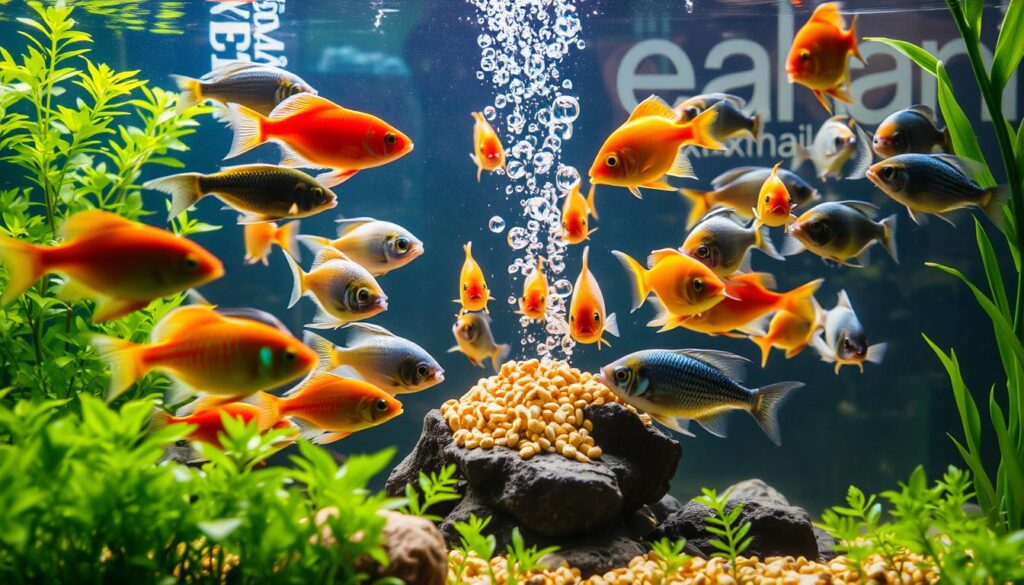
“Consistency is key when it comes to feeding your aquarium fish. Establishing a predictable routine helps them feel secure and ensures their nutritional needs are met.”
By knowing what your fish need to eat and adjusting their meals, you can make sure they get the care and food they need to thrive.
Signs Your Fish Are Hungry or Overfed
It’s important to know when your fish are hungry or overfed. This helps keep them healthy and happy. By watching their behavior and body language, you can make sure they get the right amount of food.
Behavioral Indicators of Hunger
Fish that are hungry might show these signs:
- They swim a lot around the tank, often near the top or glass.
- They seem more alert and notice you more.
- They get excited when it’s time to eat, moving quickly.
- They might even try to eat your fingers or decorations.
Physical Signs of Overfeeding
But, if your fish are eating too much, you might see these signs:
- Their bellies look big and round, showing they’ve eaten too much.
- They just float or sink, not moving much.
- You can see uneaten food floating in the water.
- They make more waste, which can make the water dirty.
Understanding Fish Body Language
Watching how your fish act can also tell you a lot. Healthy fish usually:
- Look bright and have a sleek, active body.
- Swim with purpose and confidence in their tank.
- Be alert and active when you come near or when it’s time to eat.
By knowing these signs, you can make sure your fish get the food they need to stay healthy and happy.
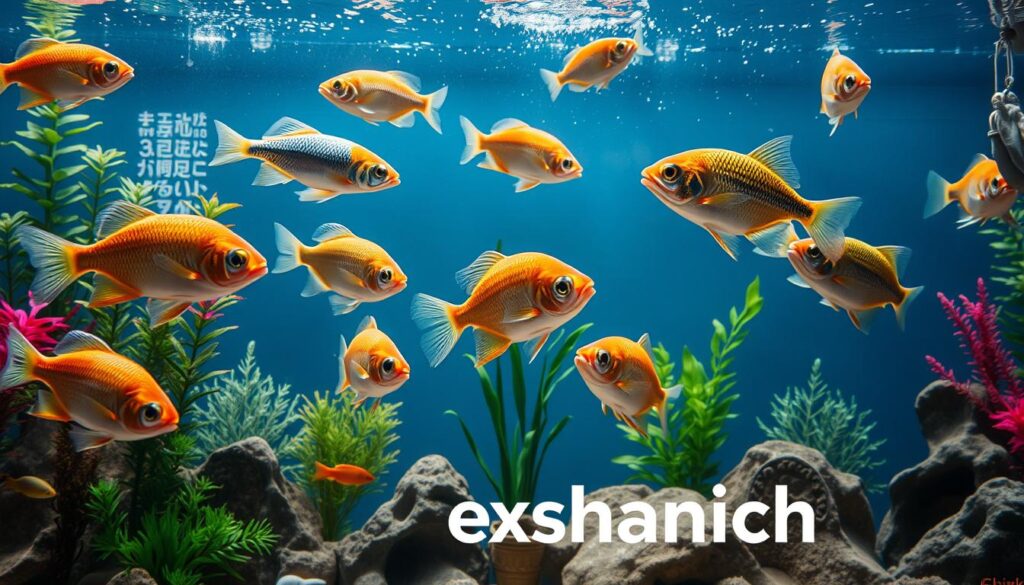
| Behavioral Indicators of Hunger | Physical Signs of Overfeeding |
|---|---|
| Actively swimming around the tank Frequently approaching the surface or glass Eager greeting at feeding time Nipping at fingers or decorations | Distended or swollen bellies Floating or sinking listlessly Undigested food visible in the water Increased waste production |
“Observing your fish’s body language can provide valuable insights into their feeding needs.”
Best Times of Day for Feeding Aquarium Fish
Creating a good fish feeding schedule is key for your fish’s health. The right time to feed can affect their behavior, growth, and overall health. Here are some tips for the best times to feed your fish.
Early morning is the best time for most fish. As night ends, they are hungry and ready for food. Feeding them then helps them use their energy well.
- Feeding around 8-10 AM in the morning helps start their day right.
- Don’t feed right after the lights come on. Fish need time to adjust and eat better.
Feeding again in the late afternoon or evening is also good. It helps them get ready for the night.
- Feed your fish in the late afternoon, around 4-6 PM, for better digestion.
- Don’t feed too late in the day. It can cause food to rot and harm the water.
Stick to a fish feeding schedule with morning and late afternoon feedings. This keeps your fish healthy and happy in their home.
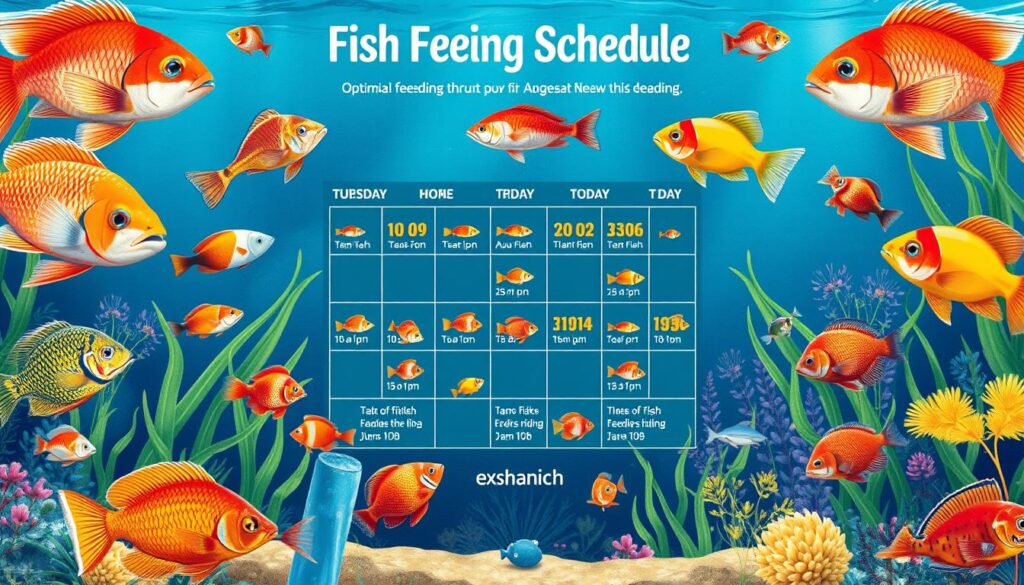
“Establishing a consistent feeding routine is key to keeping your aquarium fish healthy and happy.”
Proper Portion Sizes and Feeding Methods
Feeding your aquarium fish right is key. Knowing how much to feed and how to do it is important. This affects their health and happiness. Let’s look at how to measure food, the different kinds of fish food, and the best ways to feed different fish.
Measuring Food Quantities
Finding the right amount of food for your fish is tricky. Too much can harm the water and your fish’s health. Too little means they might not get enough nutrients. Feed them just enough so they eat it all in 2-3 minutes.
Use a small spoon or cup to measure the food. This helps you give the right amount for your fish and tank size.
Different Types of Fish Food
The food your fish needs changes with their species. Here are some common types:
- Flakes: Great for many community tanks, flakes are easy to use and balanced.
- Pellets: These are popular, especially for certain fish or diets.
- Freeze-dried or frozen foods: These are nutritious and natural, like brine shrimp and bloodworms.
- Live foods: Live foods like microworms and baby brine shrimp offer a natural diet.
Feeding Techniques for Various Species
Each fish has its own way of eating. For example, catfish and loaches do well with sinking food. Betta fish and guppies like floating food. Watch how your fish eat and adjust your feeding to match.
By knowing how much to feed, what food to use, and how to feed it, you can keep your fish healthy and happy.
Impact of Feeding Frequency on Water Quality
Keeping your aquarium healthy is more than just caring for the fish. It also means managing the water quality well. How often and how much you feed your fish greatly affects the tank’s water.
Feeding too much can cause a lot of uneaten food and waste. This waste breaks down and releases harmful substances into the water. These substances can harm the balance of your tank, causing algae, low oxygen, and sick fish.
| Feeding Frequency | Impact on Water Quality |
|---|---|
| Underfeeding | Low organic waste, stable water parameters |
| Proper Feeding | Balanced organic load, healthy water conditions |
| Overfeeding | Excess waste, poor water quality, potential fish stress |
To keep your aquarium water quality and feeding in check, finding the right balance is key. Feed your fish the right amount, so they can eat it all in a few minutes. This reduces the chance of overfeeding fish risks and keeps your tank clean and stable.
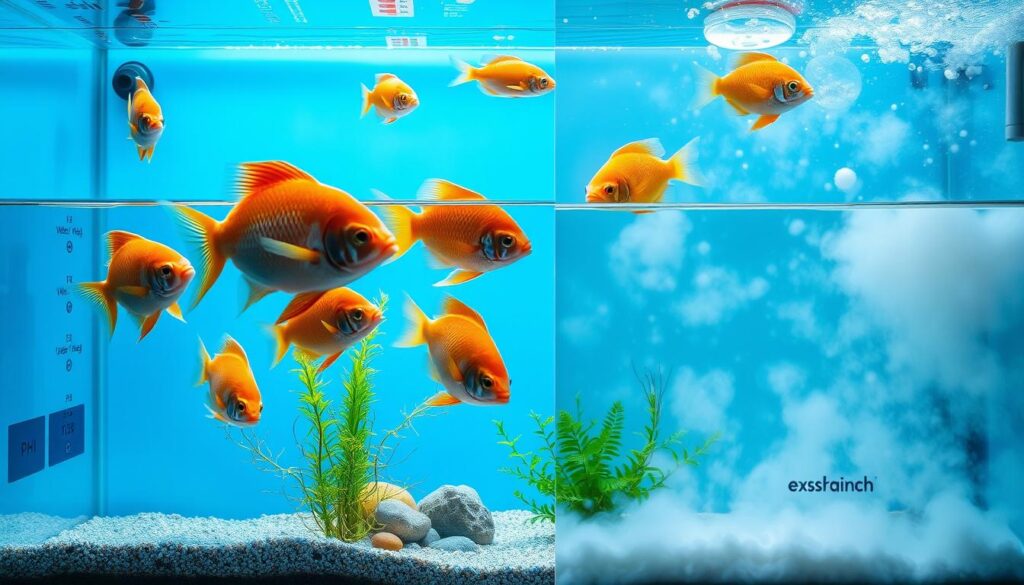
Testing the water regularly, doing partial water changes, and using good filters are also important. Knowing how feeding affects water quality helps you make better choices. This way, you can create a healthy and sustainable aquarium ecosystem.
Special Feeding Considerations for Different Seasons
As the seasons change, so do the feeding needs of your aquarium fish. It’s important to understand how seasonal changes affect their metabolism and nutrition. This knowledge helps keep your fish healthy and thriving all year.
Summer vs. Winter Feeding Patterns
In the summer, fish are more active and burn energy faster. They need more food and a diet rich in protein to keep up their energy. In the winter, fish move slower and burn less energy. They eat less and can easily get too much food.

Adjusting Food Types by Season
To meet these seasonal needs, you should change the fish food you give. In summer, feed them high-quality protein like brine shrimp, bloodworms, or krill. When it gets colder, switch to a diet with more carbs and fats to match their lower energy needs.
| Season | Feeding Frequency | Recommended Food Types |
|---|---|---|
| Summer | 2-3 times per day | High-protein foods (brine shrimp, bloodworms, freeze-dried krill) |
| Winter | 1-2 times per day | Balanced diet with higher carbohydrates and fats |
By adjusting your fish feeding schedule and food choices, you can keep your fish healthy all year. This ensures they get what they need for their best health.
Common Feeding Mistakes to Avoid
Keeping your aquarium healthy means watching how you feed your fish. Avoiding common mistakes is key to your fish’s long life and health. Overfeeding is a big problem. It can make the water dirty and harm your fish’s health.
Another mistake is not feeding at the same time every day. Fish like routine, so changing their meal times can stress them out. It’s also important to choose the right food for your fish. A varied diet helps keep them healthy and full of energy.
By avoiding these mistakes, you can make a great home for your fish. Watch how much you feed them, stick to a schedule, and pick the right food. This will keep your fish happy and healthy for a long time.
FAQ

How many times should I feed my fish in the aquarium per day?
Feed your aquarium fish 2 to 3 times a day. This keeps them well-nourished and prevents water quality problems.
What factors affect the ideal feeding schedule for my aquarium fish?
Several things affect your fish’s feeding schedule. These include the fish species, size, age, and tank conditions. Knowing these helps you create a good feeding plan.
How do I recognize when my fish are hungry or have been overfed?
Watch your fish’s behavior and look at their body. Hunger signs are increased activity and a sunken belly. Overfeeding shows as lethargy and a big belly.
What are the best times of day to feed my aquarium fish?
Feed your fish in the morning and evening. This matches their natural eating times. It keeps them healthy and their metabolism working well.
How do I determine the appropriate portion sizes when feeding my fish?
Give your fish only what they can eat in a few minutes. Too much food harms water quality and fish health. Measure food carefully based on your fish’s number and size.
How does the frequency of feeding impact the water quality in my aquarium?
Feeding too often hurts your aquarium’s water quality. It leads to more waste and bad water conditions. This can harm your fish’s home.
Do I need to adjust my fish’s feeding schedule based on the season?
Yes, change feeding times with the seasons. Fish eat more in warm months and less in cold ones. This helps them stay healthy.
What are some common feeding mistakes I should avoid when caring for my aquarium fish?
Avoid overfeeding, irregular feeding, wrong food, and ignoring water quality. Fixing these mistakes keeps your fish healthy and happy.

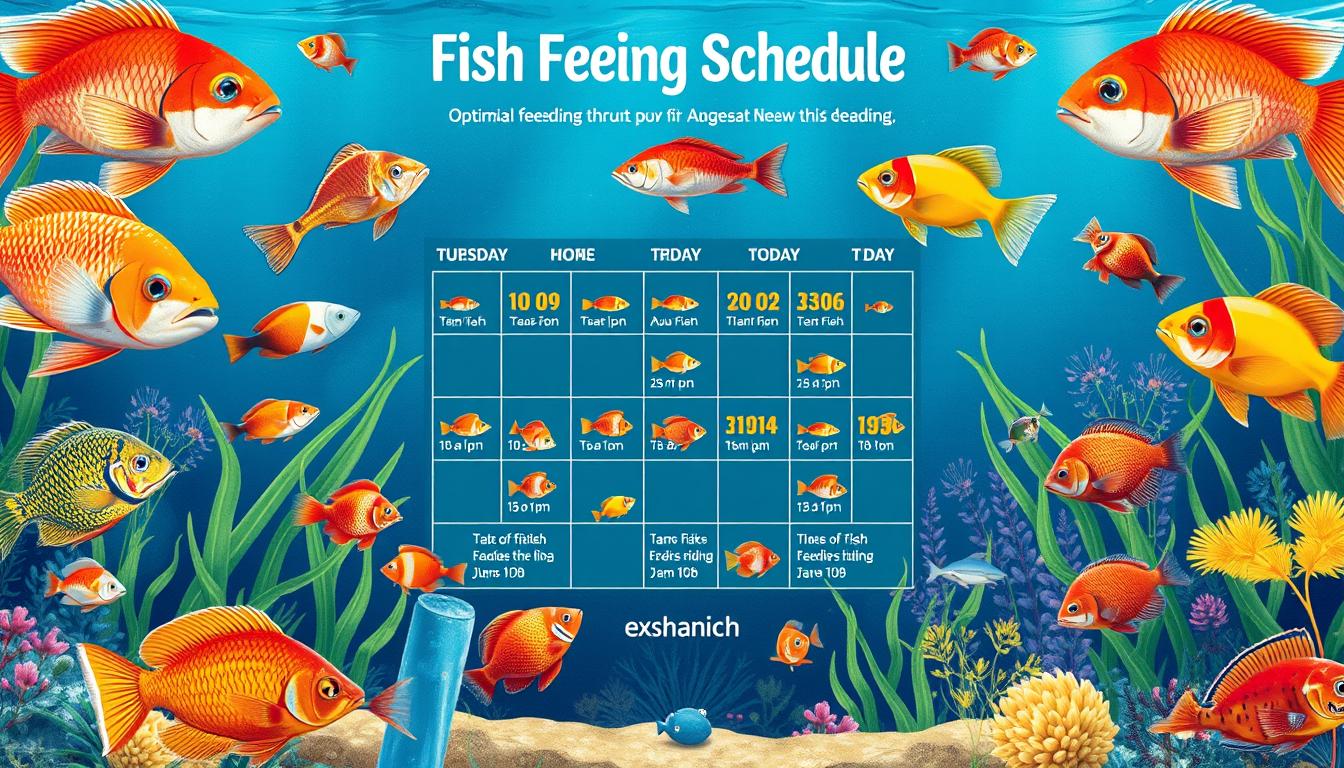


 No products in the cart.
No products in the cart.